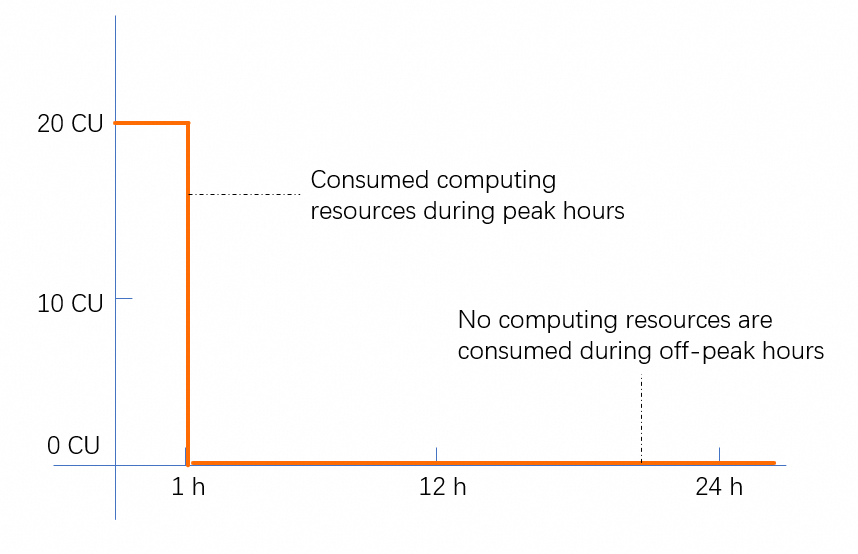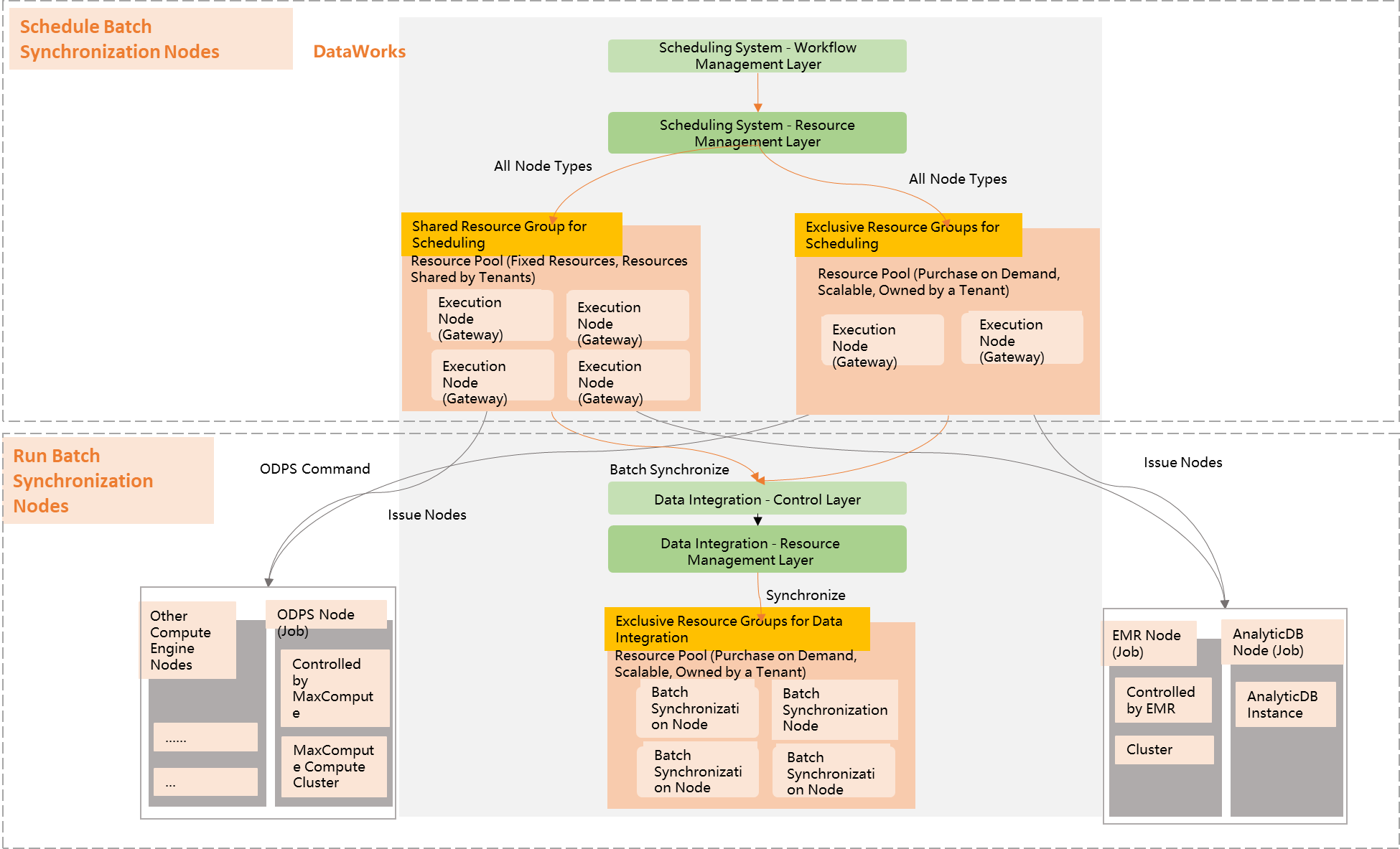A DataWorks resource group is a collection of computing resources that can be used by DataWorks services. DataWorks resource groups are a prerequisite to use DataWorks. The status of a resource group affects the stability of DataWorks services, and the quota of a resource group affects the execution efficiency of tasks or services. This topic describes the properties and characteristics of DataWorks resource groups.
Background information
To address user experience issues such as complex billing logic and inconsistent purchase management of old-version resource groups, DataWorks has been gradually releasing serverless resource groups in different regions since June 10, 2024. Old-version resource groups include the shared resource group for scheduling, exclusive resource groups for Data Integration, exclusive resource groups for scheduling, and exclusive resource groups for DataService Studio. All DataWorks features support serverless resource groups. The billing logic of serverless resource groups is clear and simple. You can use a serverless resource group to complete various operations, such as data synchronization, task scheduling, and calling and management of DataService Studio APIs.
Characteristics of serverless resource groups
General-purpose use: Serverless resource groups apply to all DataWorks services without differentiation.
Flexible billing method: The pay-as-you-go and subscription billing methods are supported.
Dynamic scaling: Tasks that are run on the resource groups are not affected when the resource groups are scaled.
On-demand use: You can purchase resources based on your business requirements to reduce resource waste. The smallest unit of purchase is two compute units (CUs).
High isolation and security: The resources in serverless resource groups are exclusive to you and you can control the network of the resource groups. This provides better security and isolation.
Billing methods of serverless resource groups
A serverless resource group uses CU as the billing unit instead of resource specifications. The performance of 1 CU is approximately equal to 1 vCPU core and 4 GiB of memory.
Task scheduling: Scheduling tasks run in serverless mode. The pay-as-you-go billing method is supported. You are charged based on the number of instances that are successfully run and the related billing tier.
Data Integration, data computing, and DataService Studio: The pay-as-you-go and subscription billing methods are supported. For more information, see the Comparison between the different billing methods of serverless resource groups section in the "Billing of serverless resource groups" topic.
For more information about the billing of serverless resource groups, see Billing of serverless resource groups.
Billing examples
A user in the China (Hangzhou) region needs to run 20 DataWorks synchronization tasks to synchronize data from a MySQL database to a MaxCompute data warehouse every day in the morning. Each task runs for one hour.
The following figure shows the consumed resources in the situation where a serverless resource group is used to run the synchronization tasks and each task consumes 1 CU per hour.
 Note
NoteThe unit price of a pay-as-you-go serverless resource group in the China (Hangzhou) region is USD 0.077399 per CU-hour.
Fees of the serverless resource group for one day = CUs consumed by a single task per hour × Unit price of CUs × Number of tasks × Running duration of tasks = 1 CU × USD 0.077399 per CU-hour × 20 CUs × 1 hour = USD 1.54798.
If you use an exclusive resource group for Data Integration, the minimum specifications of an exclusive resource group for Data Integration for you to purchase contain 4 vCPUs and 8 GiB of memory. The unit price of an exclusive resource group for Data Integration with the minimum specifications in the China (Hangzhou) region is USD 76.23 per month, which is approximately USD 2.541 per day.
Conclusion
Serverless resource groups help avoid unnecessary resource waste and reduce the resource cost by about 40%.
Limits
Serverless resource groups are supported in the following regions: China (Beijing), China (Shanghai), China (Shenzhen), China (Hangzhou), China (Hong Kong), China (Zhangjiakou), Singapore, Malaysia (Kuala Lumpur), Indonesia (Jakarta), Japan (Tokyo), UK (London), US (Silicon Valley), Germany (Frankfurt), and US (Virginia).
You are granted the required permissions.
Only RAM users to which the AliyunBSSOrderAccess and AliyunDataWorksFullAccess policies are attached can purchase resource groups. For information about how to grant permissions to a RAM user and view the permissions of a RAM user, see Grant permissions to a RAM user and View the permissions of a RAM user.
Only a workspace administrator can associate a resource group with a workspace and change the workspace with which a resource group is associated.
For information about the permissions required to perform other operations on a resource group, see Custom policies used to manage permissions on the entities in the DataWorks console.
A pay-as-you-go serverless resource group can use up to 500 CUs.
For other types of tasks except real-time synchronization tasks, a maximum of 16 CUs can be allocated to a single task.
Precautions
You have exclusive rights to use DataWorks resource groups, including serverless resource groups and old-version resource groups. Accordingly, any legal obligations and liabilities arising from the code logic executed or scheduled based on the resource groups will also be borne by you. We recommend that you adhere to relevant laws and regulations, and use resources reasonably to maintain a good community environment and protect your own rights and interests.
Comparison between serverless resource groups and old-version resource groups
Comparison item | Old-version resource group (exclusive resource groups and shared resource groups) | Serverless resource group |
Classification | Resource groups are classified into resource groups for Data Integration, resource groups for scheduling, and resource groups for DataService Studio based on their purposes. | Resource groups are used for general purposes and are not classified. |
Support for features | Some capabilities of DataWorks are not supported. | All capabilities of DataWorks are supported. |
Support for mixed use | Each type of resource group serves only one purpose. | A resource group can be used in data synchronization, scheduling, and DataService Studio at the same time. |
Sales mode | Resource groups are charged based on the specifications and the number of machines. A resource group must contain at least one machine, and the minimum specifications of a machine are 4 vCPUs and 8 GiB of memory. The minimum step size for scaling out a resource group is one machine whose specifications are 4 vCPUs and 8 GiB of memory. | Resource groups are sold by compute unit (CU). A resource group must contain at least two CUs. The minimum step size for scaling out a resource group is one CU. |
Billing method |
| Both the subscription and pay-as-you-go billing methods are supported. |
Resource waste | DataWorks provides only limited types of specifications for resource groups. This causes a specific amount of resource fragments to be generated on machines of each type of specifications. As a result, resources are wasted. | You can determine the number of CUs based on your business requirements. This prevents resource waste. |
Scalability |
| You can directly change the number of CUs for a resource group. |
Impact generated by scale-out or scale-in | Running tasks are affected. | Running tasks are not affected. |
Network security | DataWorks manages inbound and outbound Internet traffic for resource groups. The Internet bandwidth of resource groups is shared by multiple users. This causes resource competition. | Users use their own Internet capabilities, which makes the behavior of users controllable. |
Development trend | Old-version resource groups will be discontinued in the future. | Serverless resource groups will become the only resource groups that are supported by DataWorks. |
Support for custom images | Custom images are not supported. | Custom images are supported. If you use a serverless resource group to deploy tasks, you can create an image that contains all components required for running tasks. This helps meet more conditions for running tasks. |
References
For information about the billing of serverless resource groups, see Billing of serverless resource groups.
For information about how to purchase and use a serverless resource group, see Create and use a serverless resource group.
For information about how to switch from an old-version resource group to a serverless resource group, see Change from an old-version resource group to a serverless resource group.
Appendix: Old-version resource groups
Serverless resource groups support more capabilities than old-version resource groups (exclusive resource groups and shared resource groups), can be purchased in a more unified manner, and can effectively utilize resource fragments to avoid waste. We recommend that you use serverless resource groups.
